Smart on Crime Blog
Posted on: September 16th, 2015 by Waterloo Region Crime Prevention Council
One of the most anticipated highlights of our year happened last week. In case you happened to miss it (?!) – although, I’m not sure how you could – Howard Sapers was in town. Yes, THE Howard Sapers. Federal Correctional Investigator for Canada and ombudsman for federally sentenced offenders.
We partnered with Kitchener Public Library as part of their new 85 Queen Speaker Series to host this event and filled the auditorium with 230 people from our community. The action packed evening included a screening of the film “State of Incarceration”, a keynote address by Howard Sapers and a panel discussion with community members, including a formerly incarcerated woman from Grand Valley Institution for Women.
-

-
Howard Sapers oversees the Office of the Correctional Investigator, serving as an ombudsman for federally sentenced offenders.
-
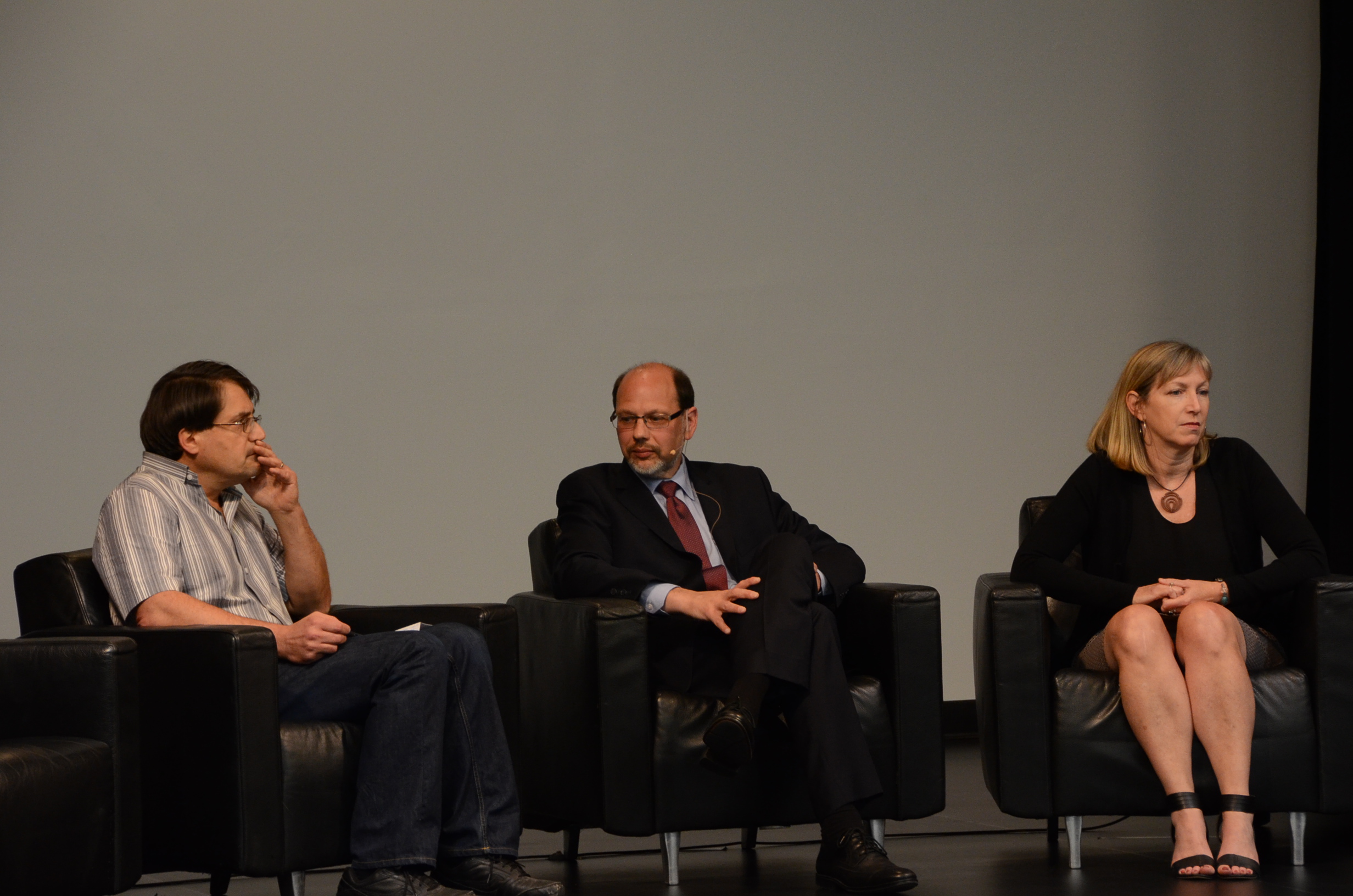
-
Panel with (from left) Chris Cowie from Community Justice Initiatives, (off camera) Joe Mancini from the Working Centre, Howard Sapers, Julie Thompson from CJI, and Dionne, (not seen, pseudonym), a former federal inmate.
-
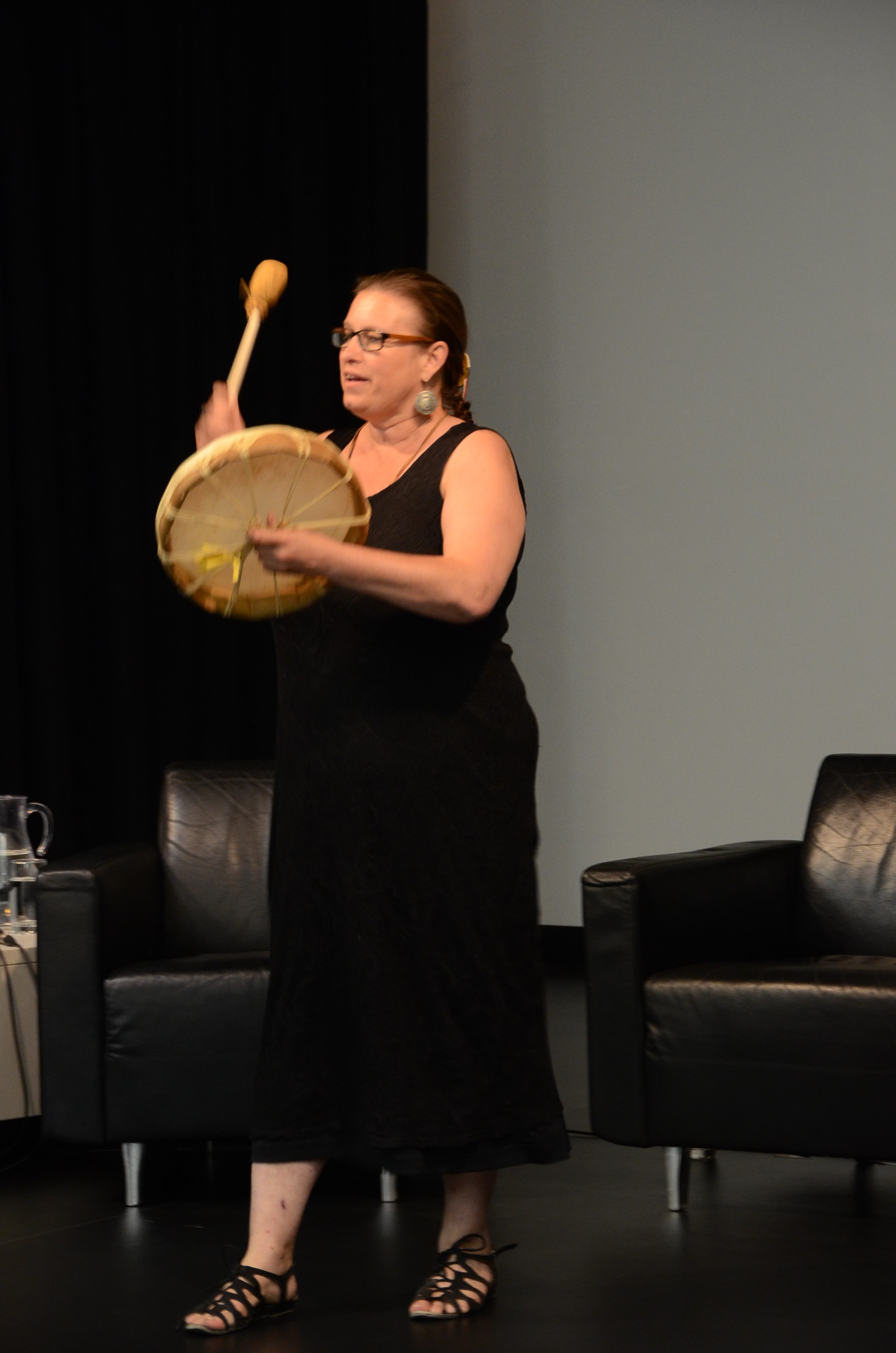
-
Aboriginal drummer Heather Majuary closed the event with drumming in honour of incarcerated Aboriginal lands.
-
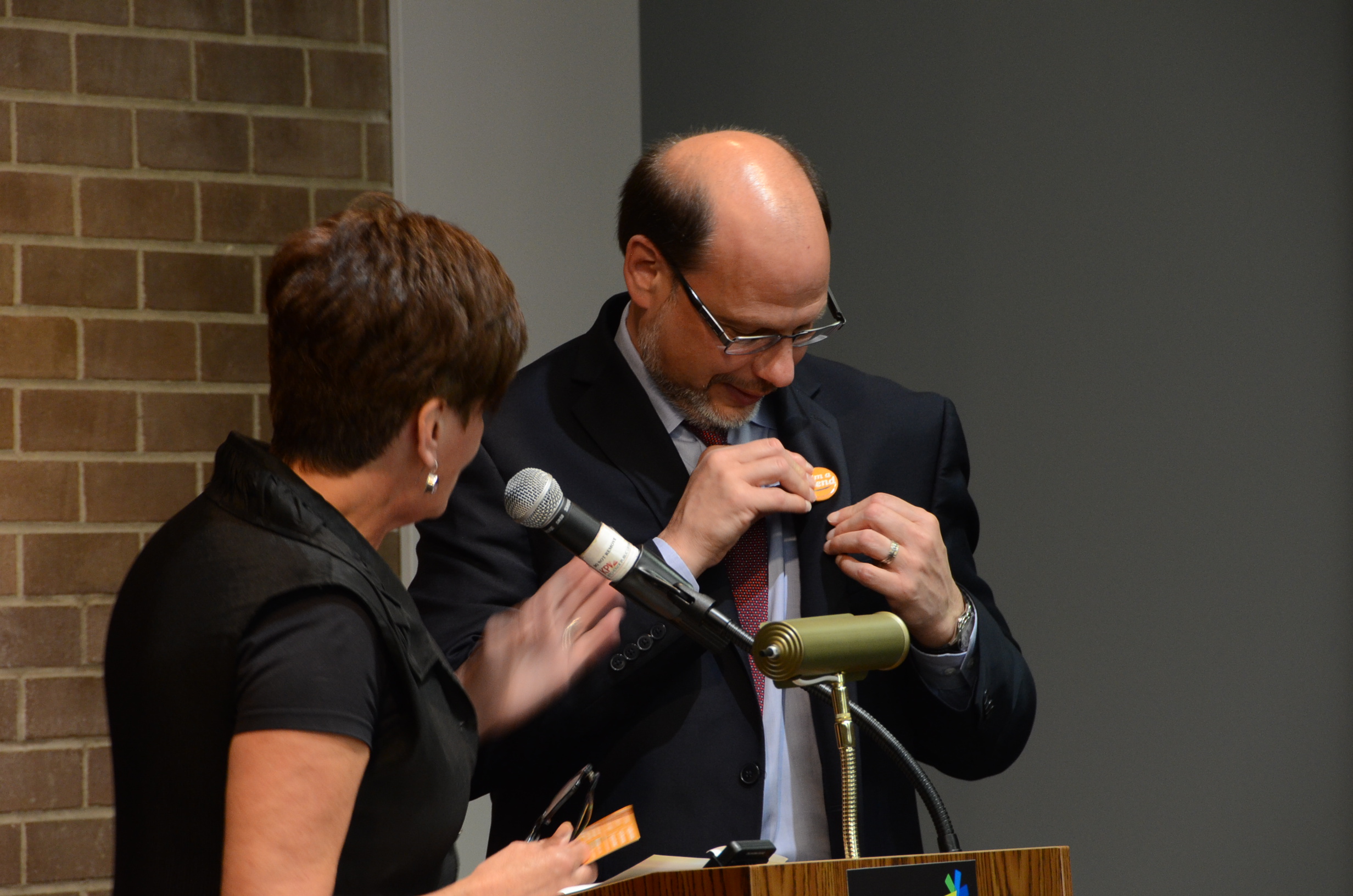
-
Howard Sapers becomes our first honourary Friend of Crime Prevention!
-
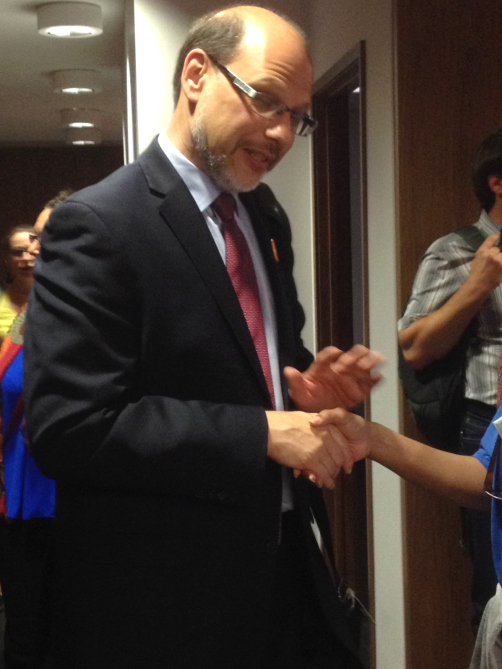
-
Howard Sapers chats with an attendee who is currently a minimum security inmate. [Source: Kitchener Public Library]
-

-
Regional Chair Ken Seiling with former parole officer Mark Yantzi, a pioneer in the field of restorative justice and past Executive Director of Community Justice Initiatives [Source: Kitchener Public Library]
-
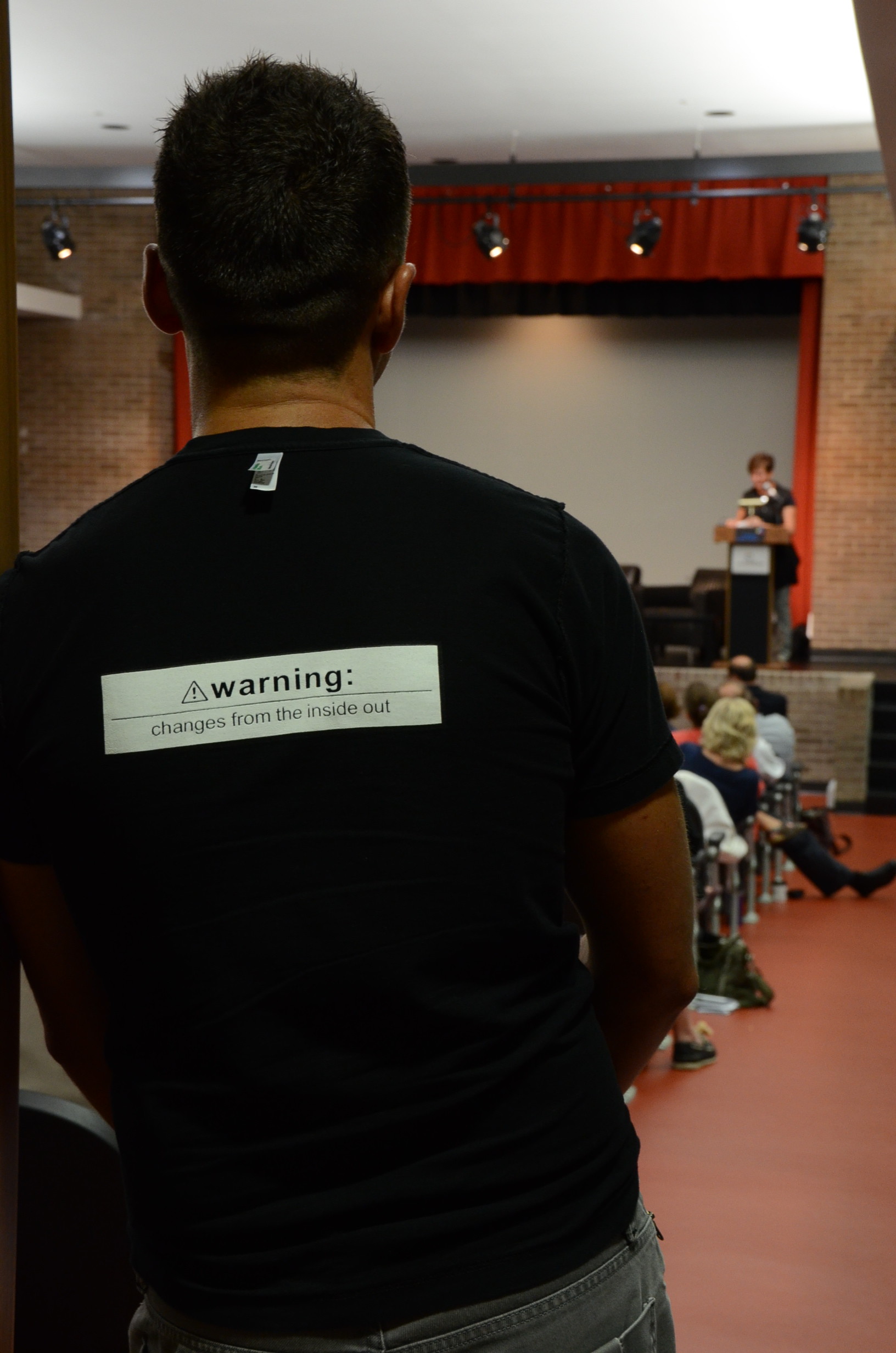
-
It’s true, change really does start from the inside. And that’s what Friends of Crime Prevention events are all about!
-

-
Howard Sapers chats with Aboriginal drummer Heather Majuary, who closed the event with drumming in honour of incarcerated Aboriginal lands
We have a video coming soon of Mr. Sapers’ keynote talk, but in the meantime, you can read his presentation here to catch all the incredible stats and stories he shared that night. He really does effectively paint a vivid picture about the state of Canadian prisons in 2015.
While you wait impatiently for the video, I”ll leave you with these two reflections from two currently incarcerated women from Grand Valley Institution for Women who attend the event. You’ll understand why it was such a big night.
Julie writes:
“I attended the forum for Friends of Crime Prevention, on September 10, 2015. I cannot begin to tell you how refreshing it is that discussions such as this are taking place. I was both shocked and pleasantly surprised at the amount of progressive people who attended the forum. There are faces and lives associated with the disturbing statistics Mr. Saper spoke of – mine is one of them. I was one of two currently incarcerated women at the event, with the Walls to Bridges Collective. Too often incarcerated people are treated as the rejects of society, disposable even, and let’s face it – advocating for us is not at the top of almost all priority lists. I firmly believe that many incarcerated people would not be in the criminal justice system to begin with, if they had been afforded access to and utilized stronger and earlier preventative measures through social intervention and more accessible social and health services; myself included. Sadly, I did not consider the flaws in our systems until I was directly affected. Now that I am, however, I cannot turn a blind eye to them anymore, not just for myself, but for the staggering amount of other people making up those statistics, and for those yet to come. I am relieved to know I am not alone in this quest. All human life has value – thank you for making “out of sight” not be “out of mind” anymore. The forum helped to humanize us and highlight some of the injustices of our daily reality. I left with a renewed sense of hope and purpose. I am thankful that this forum created a safe place for people to come together, ask questions, and push boundaries. To evoke much needed change will require more bridges to be built than walls. We have a long way to go, but I am hopeful that just as a storm starts with a single raindrop, so too does change start with forums such as this one.”
Denise writes:
Just as the world will always remember September 11, 2001, in a negative light, Thursday, September 10, 2015 will be etched in my mind for as long as I exist as an achievement to social awareness. You see, since my incarceration it was the only day in which I came in contact with people besides volunteers and members of the Walls to Bridges group and voice my dilemma while feeling safe to bare my soul. Mr. Howard Sapers provided statistics that were both daunting and hopeful. Information on how tax dollars are truly spent to build and house a growing prison population at a time where the crime rate for the past decade plus has been on the decline. I am part of those statistics and Canada is following the footsteps of the failed American system that ex President Bill Clinton and present sitting President Barak Obama stated ‘is not working’. The large majority of incarcerated people will be released and upon their discharge, are expected to function and contribute to the same society that deemed them as criminals. If education is at least a gateway to success, incarcerated people need more training to learn and utilize skills and tools required to help them successfully add to the fabric of society’s fast paced, ever changing existence. Prevention, Prisons & Popcorn at Kitchen Public Library was a forum that brought together a community of progressive thinking people aware of the challenges society will surely be faced with once the voiceless, faceless people are unconstrained. An awareness of prisons and the need for community inclusion upon the release of prisoners are part of an encompassing subject tax payers don’t realize every member of a community may be accountable for. After someone goes from inmate to civilian because they have paid their dues to a faulty justice system and they no longer live in the past where they made poor choices, when do they get a fair shot at being seen in a new light? There needs to be more discussions such as the one Prevention, Prisons & Popcorn opened up where communities are aware of their interconnectedness to their surroundings, even their walled surroundings.
Yep, it was that kind of night.
Posted on: April 7th, 2015 by Waterloo Region Crime Prevention Council
Back in February 2015, the Church Council on Justice and Corrections (CCJC), released a very promising evaluation report on the Circles of Support and Accountability (CoSA) program that operates across Canada. CoSA is a “community-based reintegration program, grounded in restorative justice principles, that holds sex offenders accountable for the harm they have caused while assisting with their task of re-entry into communities at the end of their sentences”.
The evaluation, the first of its kind in Canada, gives an in depth description of how the program works, documenting it’s success rate and cost savings due to reduced recidivism and reoffending. In short, the evaluation says that this program works.
Great news!
But then, on March 2nd 2015, it was announced that as of March 31, 2015, Correctional Services Canada (CSC) would not renew the funding it has been providing since 1996, as a partner to CoSA. The program has additional partners in numerous Canadian cities such as the Mennonite Central Committee Ontario (MCCO) for the program operated in Kitchener, Hamilton and Toronto. MCCO has funding from CSC until March 31, 2018.
CoSA Canada quickly released a statement to clarify and restate the real impacts of this program: a proven model that addresses a high risk crime against vulnerable people in a humane and accountable way and shows that it can reduce recidivism of the highest risk sexual offenders by 70 – 83%.
This is what we at the Crime Prevention Council would be inclined to call a “smart on crime” approach to reducing crime and victimization:
- the program is based in good evidence,
- the approach is measured and documented in similar ways across programs,
- it has produced excellent results,
- it is proven to reduce and prevent further crimes at a lower cost than keeping an individual incarcerated for “life”, and,
- helps to reintegrate individuals into our community, which is where 95% of people exiting prison, including those convicted of sexual offenses, will return eventually at the end of their sentences
Meanwhile, this ‘made in Canada’ approach has been successfully exported to a number of jurisdictions in the U.S. and the U.K., in addition to France, The Netherlands, Italy, Australia, New Zealand, Latvia and South Korea.
When programs show that they accomplish what they set out to do at comparatively low investment and provide a high return on investment to the safety of our community, their sustainability is not only vital, but smart and it makes so much more sense to support of them rather than cut them.
As such, the decision by CSC to cut funding for CoSA is tough to understand and needs further dialogue and consideration.
Posted on: March 25th, 2015 by Smart on Crime
Never have I seen such a beautiful collection of voices, all unique, and yet all singing the same tune. The Everyday: Freedom from Gendered Violence Symposium put on by the Social Innovation Research Group, and brilliantly detailed by Jay Harrison here, was a phenomenal representation of the intersection of research, arts, and community work. While the Symposium had a particular focus on the university experience, its messages are equally applicable in our neighbourhoods and communities as we think about crime prevention and smart approaches to the gendered violence that occurs in those spaces.
I don’t think I could ever do justice to the amazing topics that were discussed – responding to disclosure, the particular experiences of gendered violence faced by racialized and LGBTQ students, engaging men in prevention, and more. So, I thought the best way was to provide some insight from the speakers themselves:
“What does it mean to be safe?” –Dr. Jenn Root
I sat and thought, ‘good question!’ How can we talk about safety without first talking about what that means? Discussions of violence and crime prevention should always start at the roots.
“Public space is not equal for everyone.” –Tatyana Fazlalizadeh
This rang true for me. How many times have I called a friend or family member to pick me up because I didn’t want to walk alone?
“Did that really just happen?” –Dr. Michael Woodford
Dr. Woodford was speaking about the slurs and comments made to LGBTQ students. But for me, I was struck by the thought of how often we doubt ourselves, as well as our friends and our families when they tell us about something seemingly “minor” is said to them: ‘Oh come on, it’s not so bad…’
“Street Harassment is abuse.” –Tatyana Fazlalizadeh
Tatyana amazed me with this beautiful comparison of street harassment to domestic violence: if a man was yelling derogatory names at his wife, we would call it abuse. When women have cat-calls yelled at them from across the street, however, we tend to brush it off and ignore it.
“The kind of terrorism I want to talk about in this country is domestic violence.” –Judah Oudshoorn
While the media and our governments continue to feed us horrible stories of the atrocities occurring under the umbrella of terrorism, sometimes we forget about the atrocities happening much closer to home – maybe in our homes, maybe in our neighbour’s home.
“Sexual violence is a strategy of war – it is not just against the women, but also the community – it is an attempt to demoralize the community.” –Dr. Eliana Suarez
At the Crime Prevention Council, we often talk about the role of community as a building block for crime prevention. If sexual violence is designed to demoralize a community, then we, as that community, must take a leading role in preventing it.
“Either you’re violent, silent, or creating meaningful change. And if you’re silent, you’re violent.” –Judah Oudshoorn
What a powerful statement. I know which role I choose to play.
“Women are not just resilient, they are resistant – they attempt to change their circumstance.” –Dr. Eliana Suarez
“Maybe there is more than one way to be a man.” –Stephen Soucie
I felt these two quotes belonged together. Discussions around gendered violence often leave me feeling sad and hopeless. But these two spoke of hope, optimism, and change for both men and women.
“It is easier to build stronger children than to fix broken men.” –Stephen Soucie
Again, I felt another ray of hope. Through my research at the Crime Prevention Council, I have learned that early interventions have astonishing success in reducing rates of crime. This is where I think we should be investing our time, energy, and dollars.
“Compliance is important, but compassion is more important.” –David McMurray
An important reminder to wrap things up: while being “tough on crime” continues to get lots of media attention, we would be wise to look at the evidence base and the fact that the majority of “tough on crime” approaches do nothing to reduce crime. Early intervention, prevention that is proven to work, and renewed focus on humane approaches to rehabilitation and reintegration, would go much further toward reducing incidents of crime and victimization.
There were a myriad of other speakers who had insightful comments, but unfortunately, I am only able to present a small portion here. The passion in the room from each and every speaker was evident – from the researchers to the artists to the community workers. They all shared with us their struggles, and yet I came out the other side feeling hopeful and fulfilled. If they can commit themselves to this struggle, they must feel that it is important and that change can be made. As I move forward in working on my Master of Social Work thesis next year, which touches on this topic, I feel like maybe I can contribute a small portion to this struggle. Maybe, someday, we could live in a world where everyday, we were free from gendered violence.
“The struggle is real… the struggle continues” –Janice Lee
How are YOU contributing to the struggle?

Eleanor McGrath
Author: Eleanor is a Master of Social Work student at Wilfrid Laurier University. She is completing her first placement at the Waterloo Region Crime Prevention Council, working on a narrative literature review of how crime mapping can be used to implement community-based prevention initiatives. Her favourite hobbies are laughing, rock climbing, and travelling.
Posted on: February 25th, 2015 by Smart on Crime
That’s the response I usually get from friends and family when I tell them that I’ve spent the past two years coordinating a project to address gendered violence against university students. I generally concur with the exasperation, but am quick to point out that it seems unfair to expect to see less gendered violence on campus when relatively little has changed in how we address it on university campuses and in the surrounding communities in which university students live, work and play.
JOIN OUR 2-day Symposium
March 11th & 12th
Engage with campus and community participants on issues related to gendered violence against students in our community.
|
The Change Project, a university-community collaboration funded by Status of Women Canada and led by the Sexual Assault Support Centre of Waterloo Region has taken a long view approach to working toward safer campuses in our region. Over the past 2 years we have talked to over 650 students, staff, faculty and community stakeholders at Wilfrid Laurier University and the University of Waterloo as part of 2 separate needs assessments. The goal of this work has been to understand what our institutions of higher learning are doing well in terms of addressing gendered violence – both in its prevention and response – and what still needs to be done. Ultimately, our aim was to end gendered violence on campus through transforming the institutional and cultural climate of the universities and communities.
Both universities have remarkable capacity to address gendered violence and we have been inspired by the growing attention they have paid the issue over the course of the project. They are also aware of some of the gaps that need to be filled and have begun to demonstrate their capacity to do so in earnest.
What we have learned is that gendered violence – including sexual assault, sexual harassment, intimate partner violence, stalking, biphobia, transphobia and homophobia – is ubiquitous; that is, it happens wherever students are. For students in Waterloo Region that means they are encountering violence in their classrooms and residence buildings as well as in our community: our restaurants and bars, parks, buses, and neighbourhoods. In fact, previous research suggests that most incidents of sexual violence that students experience happen off-campus, outside of the geographic boundaries of the university. And students experience campus life socially, the social boundaries of which can extend quite deeply into our community.
I think this points to a need to look at gendered violence against students as a whole community concern. The efforts of our campuses to prevent gendered violence and support survivors will inevitably fall short if we do not start with a definition of the problem that takes the entire community as its focus and potential site of intervention. How we frame the problem will inform what happens next, who acts and how, and who is held accountable for ensuring student, and by extension community, safety. By broadening our frame of reference we also create an opportunity to draw connections between the gendered violence that is experienced by students with the violence experienced by other members of our community. I believe we can open new doors of possibility for developing truly innovative solutions to an age-old problem by connecting the capacity and knowledge that resides in the university with that of the community.
Are you interested in this topic? The Social Innovation Research Group invites you to join us for a 2-day symposium, Everyday: Freedom from Gendered Violence, March 11th and 12th to engage with campus and community participants on issues related to gendered violence against students in our community. Visit the SIRG website for more information about The Change Project.

Jay Harrison
Author: Jay Harrison is the coordinator for The Change Project at the Social Innovation Research Group. She has been working on issues related to gendered violence against students in Waterloo Region since 2005 when she was an undergraduate student at Wilfrid Laurier University. Jay works with social sector organizations in Waterloo Region and beyond to support their social change efforts through research and evaluation.
Posted on: February 13th, 2015 by Smart on Crime
Despite homicide being a rare event in Canada, when it happens, it is the highlight of media headlines. Television news, newspapers, and social media sources all follow the story closely. In parallel to media coverage, there is a steady growth of stories being told about crime. These are found in popular novels writing about true crimes and television dramas sensationalizing the role of police and courts. With all of this attention on crime, it might be fair to imagine that consumers’ craving for violent crime related publications and or news drives its unproportioned publicity and its media focus, however, it is much more complicated to figure out which one comes first.
Homicides attract a great deal of media attention but it’s important to remember that they make up less than 1% of all violent crimes. Although homicide rates decreased last year, the homicides that did occur were heavily reported. The media focus on violent crimes, like homicide, has a great effect on the perceptions of ordinary citizens that leads to inaccurate beliefs that crime has increased. This influence of media on perceptions of crime is evident among the citizens of Waterloo Region. For instance, in the report, Won’t you be My Neighbour, the WRCPC used survey data from 2012 to show that 61% of the respondents think there is more crime Waterloo region today than when they were a child. In addition one-third of Waterloo Region residents think crime has increased over the past five years. This is despite the crime rate having dropped dramatically over the past 25 years in Canada and Waterloo Region. When news media use inflammatory language for front page headlines this can incite fear among readers and viewers and have a profound influence on the public’s perception of violent crimes including homicide.
The rate of homicide in Canada has been in steady decline since the 1980s. In 2013, there were 505 homicides in Canada, 38 homicides fewer than the previous year, marking an 8% decrease in the homicide rate (1.44 per 100,000 population). The homicide rate has generally been decreasing since peaking in the mid-1970s. (see Figure 1- homicide rates 1963 to 2013)
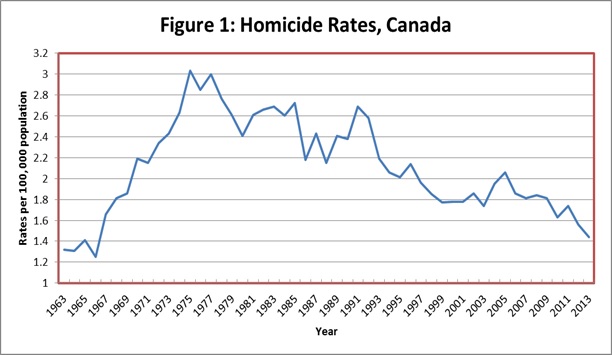
Source(s): Data on homicide are available back to 1961 in CANSIM table 253-0001.
Homicide, police-reported homicide rates, by province and territory, 2012 and 2013
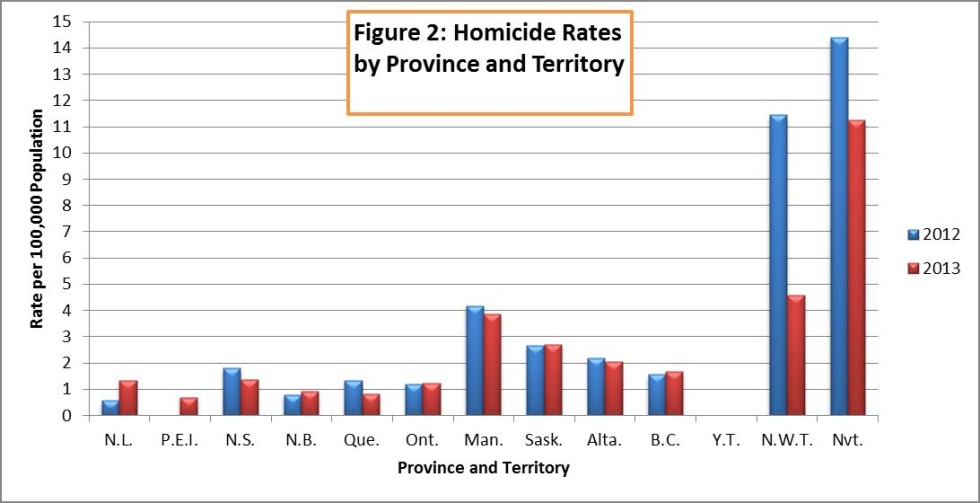
Among the provinces of Canada, British Colombia, Ontario and Newfoundland and Labrador, saw a marginal increase in homicide numbers in 2013. On the other hand, Quebec saw 40 less homicides in 2013 than in 2012. Yukon was the only jurisdiction to report no homicides (See Figure 2). Overall, the number of homicides in Canada continued to decline as of 2013 across most provinces and territories and most census metropolitan areas.
Against this backdrop, crime in Waterloo Region in 2013 showed a one year blip where our homicide rate rose above the Canadian average. From 1981 to 2013 there were 171 homicides in the Kitchener-Cambridge-Waterloo CMA; that’s an average of 5 per year. Looking just at one year snap shots though we see the number rise to as high as 11 and drop to as low as one. A wide fluctuation like this does not mean we should panic if the rate shows a one year blip, nor should we dismiss homicides as a possibility in times when the rate drops. What’s import to examine is the trend over time, which is declining in Waterloo Region just like it is declining in Canada (Figure 3).
Homicide, police-reported rates, Canada, Kitchener/Waterloo/Cambridge – 1981 to 2013
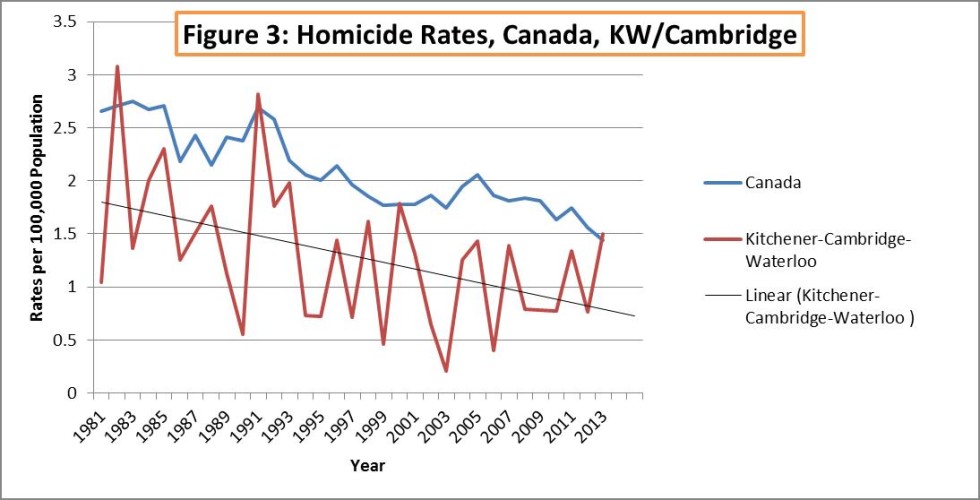
Source: Statistics Canada, Homicide Survey, Canadian Centre for Justice Statistics.
As shown above, the rate of homicides in Waterloo Region rose above the national average in 1982, 1991, 2000, and 2013. Although the increases of the homicide rate in these four years seems alarming, in every other year, stretching 32 years of homicide rate, it was consistently lower than the national average. Waterloo Region is a safe place to live with relatively few homicides. On the other hand, although the Region has a low homicide rate, one major incident can affect the statistical rates and the publication of the event with sensational headlines could incite fear among readers and viewers and potentially trigger unfounded perceptions of crime being on the rise in our community.
What do you think is a good measure of safety in our community?
Author: Asnake Meshesha is a Master of Social Work placement student with the Waterloo Region Crime Prevention Council.
Posted on: February 3rd, 2015 by Waterloo Region Crime Prevention Council
Maybe even much like February 3rd, 2015… cold, crisp and clear, with a bright full moon.
A group of enthusiastic and passionate community leaders presented the work of the Community Safety and Crime Prevention Council to Waterloo Region Council. At the time, they had been operating for almost 2 years! Their proposal on February 3rd, 1995 was to evolve from a ‘task group’ to a more formal entity, with a paid staff!
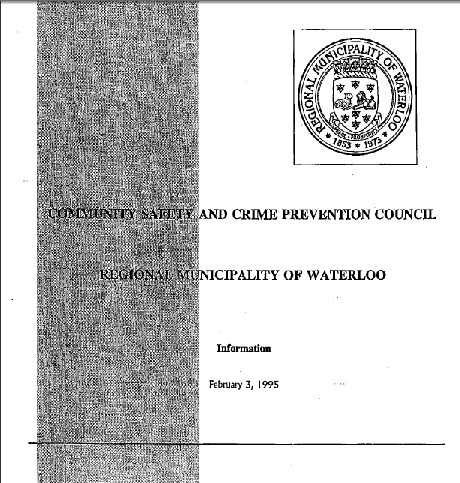

Looking back can be informative… and sometimes cringe worthy! In 20 years, our language and conceptions about crime and crime prevention have evolved so much!


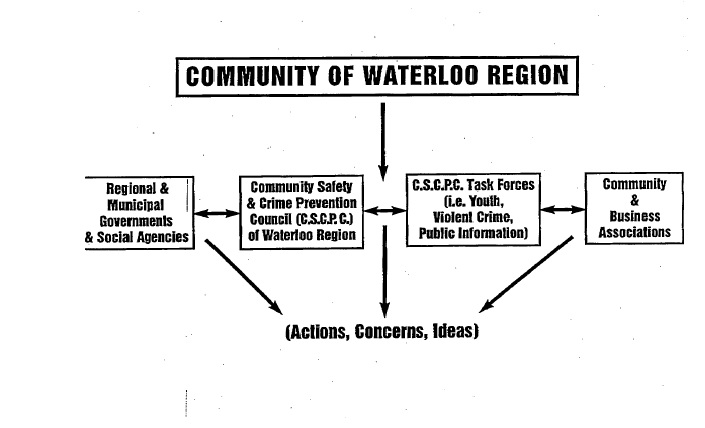
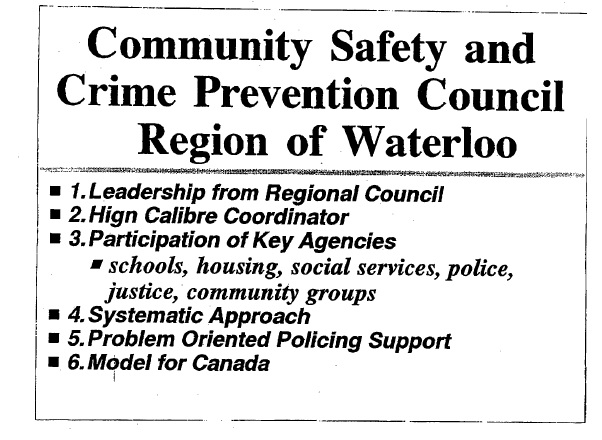
Did you catch point number two?? High calibre coordinator! That’s our very own Christiane Sadeler. She’s still the Executive Director to this day.
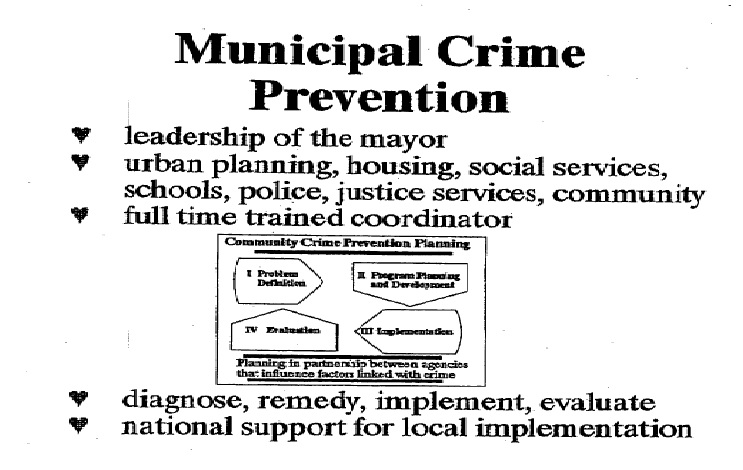
Love the heart bullet points!
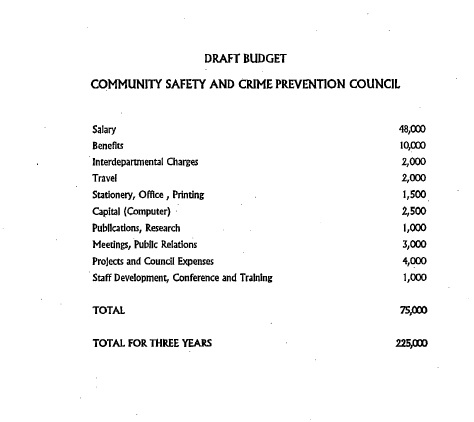
Well, there you have it folks, the presentation that launched a crime prevention through social development initiative in Waterloo Region, to the tune of $225,000 over 3 years. Such incredible growth and change over 20 years. If we had a spare $225,000 now…. well, we could do a lot of things. But one thing we would do is hire a really brilliant evaluator to capture and measure the trajectory of community change over the course of 20 years as a result of this thing we now know as the Waterloo Region Crime Prevention Council.
Can you imagine the things we would learn?
Has the WRCPC made a lasting impression on our community? What is that to you or your organization?
Posted on: December 30th, 2014 by Waterloo Region Crime Prevention Council
We’ve been in reflection mode this week at the WRCPC office. The time of year lends itself perfectly to this kind of ‘look back’ at the year that was 2014. I hope you are enjoying your own reflections. And, since we’re at it, why don’t we do some reflecting together, with the help of Smart on Crime.
We had such a variety of blog posts this year, ranging from what we were reading to crime stats, to special posts from Friends of Crime Prevention. Early in 2014, we wrapped up a year long examination of the root causes of crime. With the end of inREACH in Waterloo Region, we took some time to share what our community has learned from inREACH and engage our community in a follow up event in April where planned next steps. We even introduced you to some new words to enrich your vocabulary! And of course, we couldn’t help but challenge our community with some harder hitting posts.
Our readers are as diverse as our blog posts, which would explain the diversity of popular blogs this year. Here’s the round up of our top 14 posts from 2014.
- Public Opinion & Crime – Anthony Piscitelli
“Since 2006 the Canadian government has focused on being tough on crime. The policy approach continues to this day but it seems the Canadian public is starting to see these changes as a policy excess. Instead of focusing on punishment, public opinion polls suggest the government focus should be on prevention through education and social development programs.”
- Trent’s Trajectory: The dollars and $ense of crime prevention
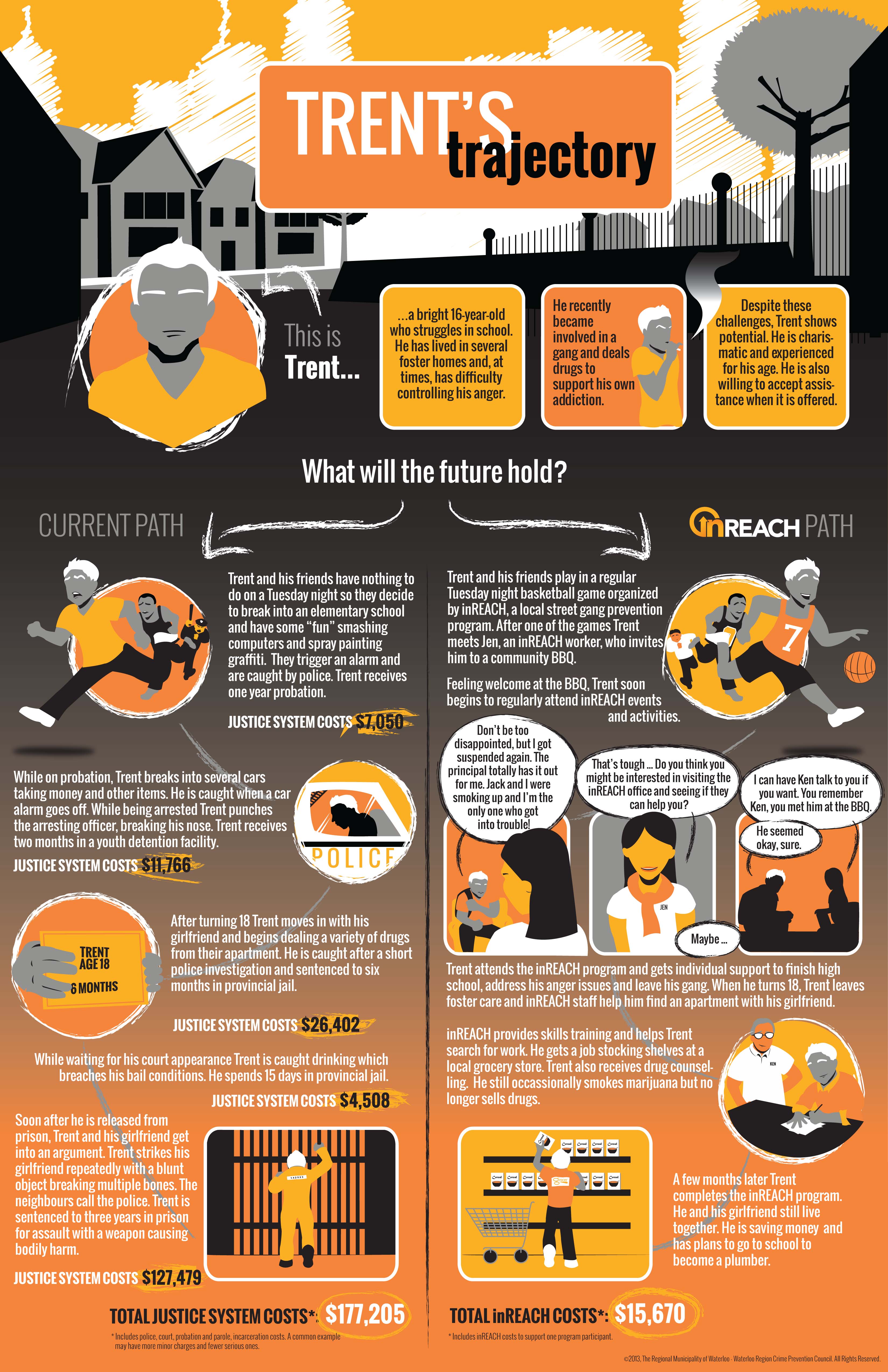
- A new story is needed – guest post by Friend of Crime Prevention, Doug McKlusky
“As a Friend of Crime Prevention, I believe that that the heart of crime prevention is through social and community development…..
Imagine neighbourhoods where everyone feels a sense of belonging, where inclusion trumps fear.
Imagine workplaces where people belong, and where respect and collaboration trump power and politics.
Imagine schools where belonging trumps bullying and streaming.”
- The new story continues…. – guest post by Friend of Crime Prevention, Doug McKlusky
“I do believe that many small actions will add up to a large action on the road to building a community of belonging. It can be as simple as acknowledging the presence of a homeless person in downtown Kitchener, they are part of our community, a friendly smile goes a long way in making a person feel like they belong. I challenge you to do something to make our community a community of belonging, smile at a stranger, volunteer somewhere in your community, it will make a difference, it will connect you!”
- Inspired by inREACH: Reflections of a youth outreach worker – Youth Outreach Worker, Krista McCann
“inREACH fostered a working environment that not only allowed us, but encouraged us to work outside of the box. I’d be lying to say the task was not daunting at first. In my previous experience working as a Youth Worker I had never been given such flexibility and confidence within a position to achieve the desired outcome; an outcome that was not based on the amount of programs ran or number of program participants but the ability to engage youth in their community.”
- Neighbourhood policing: A learning opportunity for Friends of Crime Prevention – WRCPC Student, Ryan Maharaj
“To usher in 2014, WRCPC hosted a learning event on ‘Neighbourhood Policing’. Naturally, Friends of Crime Prevention & WRCPC have a common interest with the police on all things related to crime prevention, community safety and well-being. Inspector Kevin Thaler from the Waterloo Regional Police Service was our guest to unveil the recent sweeping changes to their organizational structure, daily operations and dispatch methods. The results are what is now known as Neighbourhood Policing.”
- Between life and death: Responding to drug overdoses in Canada – former WRCPC student, Kayla Follet
This article appeared in the July 14, 2014 edition of the Waterloo Region Record.
- By the numbers: Wading through police-reported crime statistics 2013 – Anthony Piscitelli
“Statistics Canada released their annual Police-reported crime statistics 2013 report in July (and in French). There is always so much to sift through and interpret. Learn more from the Canadian Criminal Justice Association.”
- By the numbers: Hate crimes in Waterloo Region – Anthony Piscitelli
“In 2009, the Kitchener-Cambridge-Waterloo census metropolitan area (CMA) had the highest hate crime rate in Canada, according to police reported statistics. Did you catch the end of that sentence? “…..according to police reported statistics”. It might seem insignificant, but it might be the key to understanding why the 2009 hate crime rate in Waterloo Region is so high compared to other CMAs in Canada. “
- No clichés: A reflection on working with the youth of inREACH – guest post by Karl Garner
“Having been with inREACH, it became quite evident, that the youth we worked with often experienced clichés in their lives. They were labeled, stereotyped, and their behaviours were often predicted by the adult world around them, yet most of the time no one knew anything about them. Outside of where they lived, or who they hung out with, or the school they went to, or perhaps what they look like, do many even know these youth? The label which is the umbrella they live under is their cliché.”
- Ignoring what we’ve learned. Or, how to ensure street gangs become a real problem in Waterloo Region – Ryan Maharaj
“It’s easy to assume that we should apply what we’ve learned from the inREACH project to better support marginalized youth in our community. But have you every stopped to wonder, what happens if we ignore what we’ve learned? What if we shed the rose-coloured glasses and donned the shades of pessimism to see the barriers that stand in our way? What if we tried to see the glass half empty? How can we make a problem like street gangs in Waterloo Region, worse?”
- The community weighs in on the root causes of crime: change and action – Dianne Heise
“How do we get at the root causes of crime and prevent it from happening in the first place?
This isn’t a direct, straight answer, but, the Waterloo Region Crime Prevention Council believes part of the solution is to monitor the root causes of crime over time. Then we, as a community, can better understand and address the social, community and economic conditions associated with crime and victimization. Check out the Waterloo Region Crime Prevention Council’s report – A Snapshot in Time: The Root Causes of Crime in Waterloo Region to find out how we are doing in early childhood development, employment, community trust and other important indicators.”
….. and part 2 of The community weighs in on the root causes of crime: change and action
- Why communities need neighbourhood-based programming for youth – guest post by Courtney Didier, Alison Neighbourhood Community Centre
“We have worked with youth who have great dreams and aspirations for the future, but have trouble putting their vision into a workable plan. On the other side of the coin, we have worked with youth who have little to no confidence in their abilities, thus requiring a little more encouragement and a little more trial and error in determining what really gets them motivated and excited.”
- Lessons learned in a gang project – Dianne Heise and Rohan Thompson
“Gang Prevention Is…. a) addressing underlying issues, and, b) not about getting a kid to take off the bandana. We often heard – “we’ve got this kid, he’s in a gang – fix him.” So often in our case management and system navigation work, it wasn’t about getting this young person to take off his bandana or to stop hustling or whatever, we never approached the work in that fashion. But it was about the underlying issues and working on them. Mostly we were dealing with issues of poverty, untreated trauma, family breakdown, substance abuse, disengagement and lack of opportunities. These are the problems that young people and gang members and people in general are dealing with. We want to demystify that label of gang member that says their needs are different than any other groups. These same issues are the drivers behind the behaviours.”
So many great reads from 2014. But if you’re in the mood for something to watch, rather than read, might I suggest our newest video on Collaboration!
We look forward to bringing more great Smart on Crime blogs for you in 2015. Better yet, we love hearing your comments, reactions and responses to the posts and guest commentaries. We look forward to hearing more from you next year!
Posted on: August 29th, 2014 by Waterloo Region Crime Prevention Council
In 2009, the Kitchener-Cambridge-Waterloo census metropolitan area (CMA) had the highest hate crime rate in Canada, according to police reported statistics. Did you catch the end of that sentence? “…..according to police reported statistics”. It might seem insignificant, but it might be the key to understanding why the 2009 hate crime rate in Waterloo Region is so high compared to other CMAs in Canada.
A criminal offence against a person or property is considered a hate crime when there is evidence that the offence was motivated by hate, based on the victim’s: race, ethnic origin, language, colour, religion, sex, age, mental or physical disability, sexual orientation, or other similar factors. In 2009, in Waterloo Region, Police identified 93 crimes that fit this definition. While the number doesn’t tell us the nature of these reported hate crimes, these 93 situations represent the number of crimes that came to the attention of police that were classified as hate crimes in 2009.
But before we jump to conclusions about Waterloo Region being a hot bed of hate and discrimination, we might want to take a look at other cities and regions. St. John’s, Saint John, Barrie and Thunder Bay reported zero hate crimes incidents in 2009 and Saguenay, Trois-Rivieres and Greater Sudbury reported one hate crime incident each. When it comes to any urban centre, we can be reasonably confident that zero or one hate crime per year might have more to say about what comes to the attention of police and how it is classified than reality.
What we might conclude from the Census Metropolitan report in 2009 is that the reporting approaches are at this time too diverse to portray an accurate cross city picture. Comparisons between jurisdictions require similar reporting standards and such consistency did not exist in 2009. Thus, higher numbers might point to a more rigorous reporting and/or greater community attention to an issue.
By just looking at the numbers alone, Kitchener-Waterloo was put on one of eight worst places in Canada to move to for immigrants. This use of data without context was easy to share as a quick sound bite, but provided a woefully inaccurate picture of the community.
But the report is not fully useless by any stretch of the imagination. What we can and should do is use the data to compare hate crime rates over time. Such comparison works on the assumption that Waterloo Regional Police Service are more or less consistent in how they define and report hate crimes from year to year. On that basis Waterloo Region saw a steady decline in hate crimes from 93 in 2009, to 55 in 2010, to 41 in 2011 and 30 in 2012. That is a promising emerging trend. There is a BUT…
One hate crime is simply one hate crime too many. Crime prevention and the creation of a peaceful (read “inclusive”) society are intimately linked. And there can be no peace without inclusion. Understanding the nature of hate crimes in Waterloo Region should be a critical next step in our shared goal of creating a community that is safe for everyone. Armed with information about who the victims of hate crimes are, who has committed the offences, and what trends we observe overall provides us with data that can help us to begin to prevent these crimes.
 In 2012, the KW Multicultural Centre, along with numerous community partners developed a series of workshops designed to help community members better understand hate crimes, learn how to recognize potential hate crimes, how to help victims and what to do in the event of witnessing an incident that might be a hate crime. The workshop materials were designed in a way that those who completed it could deliver the workshop to other groups. To date, more than 15 workshops have been conducted in our community with over 250 people taking the training. These and other efforts help to raise awareness about the importance of hate crime prevention.
In 2012, the KW Multicultural Centre, along with numerous community partners developed a series of workshops designed to help community members better understand hate crimes, learn how to recognize potential hate crimes, how to help victims and what to do in the event of witnessing an incident that might be a hate crime. The workshop materials were designed in a way that those who completed it could deliver the workshop to other groups. To date, more than 15 workshops have been conducted in our community with over 250 people taking the training. These and other efforts help to raise awareness about the importance of hate crime prevention.
In an effort to do our part and continue the dialogue and problem solving, the Waterloo Region Crime Prevention Council recently released a RAP Sheet on Hate Crimes. The RAP sheet contains a number of suggestions on “what you can do” to address and prevent hate crimes. We are also committed to continuing to watch the data and educate ourselves by speaking to those who have lived experiences. Watch this page and our website for information we gather and for what we are learning. Also watch for how you can stay or get involved.
Meanwhile, we are keen to learn what you think! We are especially keen to learn what ideas you have to prevent hate crime before it happens.
Author: Anthony Piscitelli is Supervisor, Planning & Research with the Waterloo Region Crime Prevention Council. He collaborates on all research efforts published by WRCPC.
Posted on: August 12th, 2014 by Waterloo Region Crime Prevention Council
Statistics Canada released their annual Police-reported crime statistics 2013 report in July (and in French). There is always so much to sift through and interpret. But here’s a beginning summary of the highlights from the Canadian Criminal Justice Association.
The police-reported Crime Severity Index (CSI), which measures the volume and severity of crime, declined 9% in 2013 compared with 2012. This was the 10th consecutive decline in the index. The CSI was 36% lower than 10 years earlier.
The traditional crime rate also declined in 2013 compared with 2012, falling 8%. It continued its long-term downward trend that began in the early 1990s, reaching its lowest level since 1969. Since 1962, the traditional crime rate has measured the volume of crime, but does not take into account the severity of crimes.
Canadian police services reported just over 1.8 million criminal incidents (Criminal Code offences excluding traffic) in 2013, down approximately 132,000 from the previous year.
Most offences were down in 2013. The decline in the CSI was specifically attributable to declines in breaking and entering and robbery. Decreases in some of the less serious but very frequent offences, such as theft of $5,000 or under and mischief, also contributed to the drop in the CSI.
However, some offences were up in 2013. In particular, police services reported more incidents of extortion, child pornography, aggravated sexual assault (level 3), sexual violations against children and identity fraud.
Crime Severity Index down in most provinces and territories
In 2013, most provinces and territories recorded a decrease in their CSI compared with 2012. However, the CSI increased in Yukon (+6%) and Newfoundland and Labrador (+1%).
Prince Edward Island, New Brunswick, Quebec and Manitoba (-12% each) recorded the largest declines among the provinces and territories.
In most provinces, the decline in the CSI was largely due to fewer breaking and entering incidents. However, in British Columbia, robberies were behind the decline in the CSI. In the Northwest Territories, a decrease in homicides resulted in the drop in the CSI, whereas the decline in Nunavut was due to a large decrease in incidents of mischief.
As in previous years, each territory had a higher CSI than any province. Saskatchewan had the highest CSI among the provinces, while Ontario had the lowest.
Crime Severity Index down in almost all census metropolitan areas
For the first time since 1998, the first year for which the CSI was calculated, none of Canada’s census metropolitan areas (CMAs) recorded an increase in its CSI. The CSI was unchanged in Edmonton, while it declined in all other CMAs. The largest decrease compared with 2012 was in Victoria (-17%).
Despite a 7% drop in its CSI, Regina had the highest CSI of any CMA, while Barrie and Guelph had the lowest.
Violent Crime Severity Index continues to decline
The violent CSI fell 10% in 2013 compared with 2012, marking the seventh consecutive decrease.
Canadian police services reported approximately 384,000 violent incidents in 2013, down about 32,000 from the previous year. The decline in the violent CSI was mainly due to a decrease in robberies and, to a lesser extent, fewer assaults with a weapon or causing bodily harm (level 2), common assaults (level 1) and uttering threats.
Police reported 505 homicides in 2013, down 38 from 2012. The homicide rate was 1.44 victims per 100,000 population, the lowest rate since 1966. Police also reported 642 attempted murders in 2013, down 23 from the previous year.
Every province and territory except Newfoundland and Labrador saw a decrease in their violent CSI compared with 2012. Similarly, every CMA saw their violent CSI decline except Trois-Rivières, St. John’s, Brantford and Calgary, which recorded increases.
Increase in police-reported “sexual violations against children”
In 2013, the police reported 4,232 incidents in the “sexual violations against children” category, 279 more than in 2012. This was one of the only violent crime categories to increase in 2013.
The “sexual violations against children” category includes five specific offences under the Criminal Code: luring a child via a computer, sexual exploitation, sexual interference, invitation to sexual touching and making sexually explicit material available to a child. However, this category excludes sexual assaults against children, which are classified with all other sexual assaults, including those against adults.
Of the sexual violations against children, luring a child via a computer showed the greatest increase, rising 30% in 2013, followed by sexual exploitation (+11%). In contrast, invitation to sexual touching decreased 5%.
Non-violent Crime Severity Index is down
Most crimes reported by the police are non-violent. Police reported just over 1.4 million non-violent incidents in 2013, or nearly four crimes in five, of which 1.1 million were property crimes. The non-violent CSI decreased 8% compared with 2012, the 10th consecutive decrease in this index. The non-violent CSI was 40% lower than a decade earlier.
While most non-violent offences declined in 2013, the decrease in the non-violent CSI was mainly due to a large drop in the number of incidents of breaking and entering, theft of $5,000 or under and mischief. However, some offences in the non-violent category rose in 2013, specifically counterfeiting, child pornography and identity fraud.
Almost every province and territory saw their non-violent CSI decline in 2013. The largest decreases were in New Brunswick and Prince Edward Island, while the non-violent CSI was stable in Newfoundland and Labrador and increased in Yukon.
Most CMAs also saw a decrease in their non-violent CSI except Edmonton, where the index rose in 2013 as a result of more motor vehicle thefts and theft of $5,000 or under.
Youth Crime Severity Index down for the fourth consecutive year
The youth CSI fell by 16% in 2013 compared with 2012, the fourth consecutive decline. The youth CSI measures the volume and severity of crimes for which an accused aged 12 to 17 was identified.
The decline in the youth CSI was mainly due to fewer youths accused of robbery, breaking and entering or theft of $5,000 or under.
Every province and territory except Yukon saw their youth CSI decline compared with 2012. Among the provinces, Saskatchewan recorded the highest youth CSI, while British Columbia, Ontario and Quebec had the lowest.
With the release of the Statistics Canada report also comes analysis and critique of the statistics. Here’s a few that we read:
Did you see anything that surprised you in the Statistics Canada report? Encouraged you? Alarmed you?
Posted on: June 30th, 2014 by Smart on Crime
We believe in just and humane approaches to crime and its consequences. It says so right in our organizational value statements. And we love it when we can point to other examples of people and organizations walking the talk on this value.
Insight-Out shows that personal transformation can be a powerful force for rehabilitation before punishment. In the United States, “the system profits by its own failure’, remarks Jacques Verduin, Insight-Out founder & facilitator. And he vows to change that, person by person with a year long program called GRIP.
Does society really benefit if we abandon people in prison? What does ‘ just and humane approaches to crime and its consequences’ look like to you? What does it look like in Canada?
Read a full article about Insight-Out on the Daily Good – Guidng Rage into Power.























 In 2012, the
In 2012, the